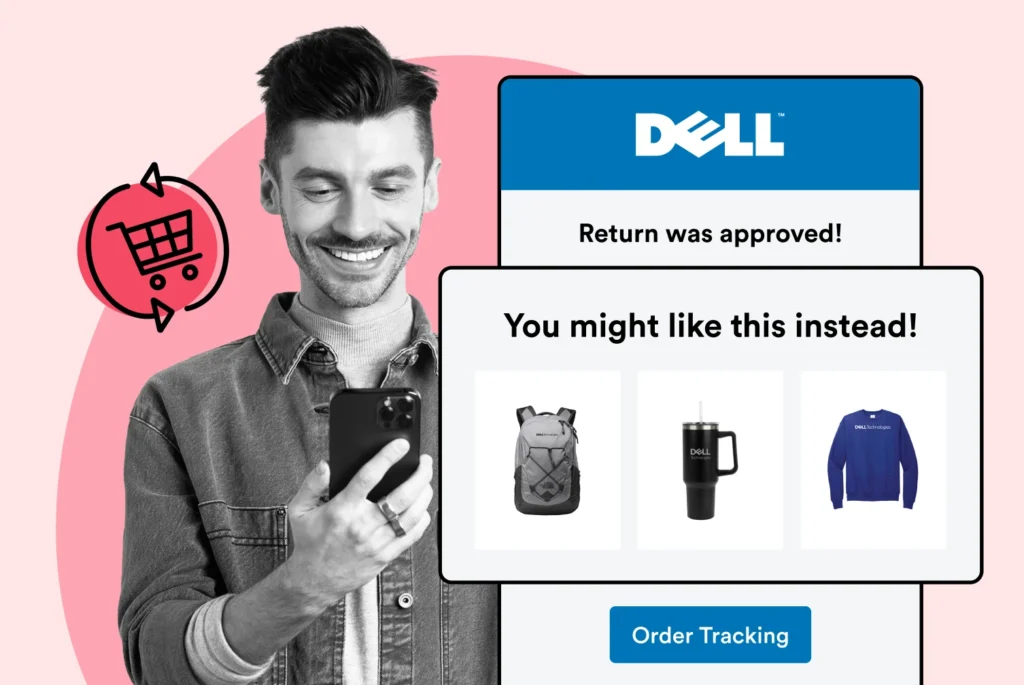
Mastering Ecommerce Returns: A Powerful Operational Guide
Streamline your returns process, utilizing best practices that reduce costs, improve customer loyalty, and protect your bottom line!
Shipping, Tracking & Notifications
Boost customer experience and reduce support tickets
Realtime order and shipment tracking
Proactive order and shipping notifications
AI-Enhanced Discounted Labels
Predictive pre-purchase estimated delivery dates
Self-Serivce branded order tracking
Effortless experience delivered
Identify and Resolve Order Issues
Realtime order and shipment tracking
Make returns profitable and delight customers
Flexibility to define any return destinations & conditions
Simplify returns for your customers and team
Incentivize exchanges over returns
Returns management made easy for your team
Returns management made easy for your team
Easy claims and smart upsells
Understand why your customers are returning
In-Store & Curbside Pickup
Unify the online and the in-store experience
Hassle-free pickup experience for customers
In-Store dashboard to keep operations streamlined
In-Store and Online orders unified
Drive foot-traffic to your stores
Shipping, Tracking & Notifications
Boost customer experience and reduce support tickets
Realtime order and shipment tracking
Proactive order and shipping notifications
AI-Enhanced Discounted Labels
Predictive pre-purchase estimated delivery dates
Self-Serivce branded order tracking
Effortless experience delivered
Identify and Resolve Order Issues
Realtime order and shipment tracking
Make returns profitable and delight customers
Flexibility to define any return destinations & conditions
Simplify returns for your customers and team
Incentivize exchanges over returns
Returns management made easy for your team
Returns management made easy for your team
Understand why your customers are returning
In-Store & Curbside Pickup
Unify the online and the in-store experience
Hassle-free pickup experience for customers
In-Store Dashboard to keep operations streamlined
In-Store and Online orders unified
Drive foot-traffic to your stores
Boost customer experience and reduce support tickets
Realtime order and shipment tracking
Proactive order and shipping notifications
AI-Enhanced Discounted Labels
Predictive pre-purchase estimated delivery dates
Self-Serivce branded order tracking
Effortless experience delivered
Make returns profitable and delight customers
Flexibility to define any return destinations & conditions
Simplify returns for your customers and team
Incentivize exchanges over returns
Returns management made easy for your team
Equip your team for precise return checks.
Easy claims and smart upsells
Understand why your customers are returning
Unify the online and the in-store experience
Hassle-free pickup experience for customers
In-Store Dashboard to keep operations streamlined
In-Store and Online orders unified
Drive foot-traffic to your stores
Find the answer to all your questions
Take a step by step trip through our functionality to see how we can improve your ecommerce processes.
Explore the most comon questions about WeSupply
Calculate the ROI that WeSupply can bring you
Read actionable articles on how to optimize your post-purchase experience and decrease support tickets
Get inspired by stories of how our customers implemented an effortless post-purchase experience
Wondering if WeSupply is a good fit for you? Read through our use cases to see how we can help you increase conversion & improve CX!
A Deep Dive into Top Companies' Order Tracking & Returns Strategy
Find the answer to all your questions
Explore the most comon questions about WeSupply
Calculate the ROI that WeSupply can bring you
Request a no strings attached review of your current shopping experience and missed conversion opportunities
Take a step by step trip through our functionality to see how we can improve your ecommerce processes.
Read actionable articles on how to optimize your post-purchase experience and decrease support tickets
Get inspired by stories of how our customers implemented an effortless post-purchase experience
A Deep Dive into Top Companies' Order Tracking & Returns Strategy
Wondering if WeSupply is a good fit for you? Read through our use cases to see how we can help you increase conversion & improve CX!

As businesses compete on a global stage, effective cross-border shipping becomes a game-changer. In this guide, you’ll discover how to refine your shipping operations to outpace competitors. Learn to navigate customs, utilize tech, and streamline logistics—without the jargon. Whether you’re scaling up or laying the groundwork, these strategies will enhance your cross border shipping and equip you to conquer international markets with confidence.
Strategic warehouse placement near borders facilitates efficient cross-border shipping, reduces costs, and mitigates risks of supply chain disruptions.
Streamlined customs clearance processes and accurate documentation are essential for smooth cross-border shipments, with knowledge of duties and taxes being critical to avoid delays and financial losses.
Employing Transportation Management Systems (TMS) and crafting transparent shipping policies with detailed costs in local currencies are instrumental in optimizing cross-border logistics and enhancing customer experience.
WeSupply enhances cross-border shipping efficiency through seamless carrier collaboration, real-time shipment tracking, and automated returns. Integration with third-party tools streamlines customs and reduces delays, while real-time tracking and proactive notifications keep customers informed. Automated returns, including self-service options and fraud prevention, reduce errors and save time. Multiple return options and robust analytics improve convenience, sales, and customer retention. Get started with WeSupply today and revolutionize your shipping process!
Engaging in cross-border shipping is a strategic decision that comes with its unique set of challenges and opportunities. One of the most significant challenges in recent times has been the impact of the COVID-19 pandemic on international logistics. The pandemic disrupted supply chains and transportation networks worldwide, causing unprecedented delays and disruptions in cross-border shipping.
However, every challenge presents an opportunity for innovation and growth. Businesses that could quickly adapt to these changes and devise effective cross-border shipping strategies were able to turn these challenges into opportunities. They managed to reduce shipping costs, improve their supply chain efficiency, and expand their reach in the international market.
In the following sections, we’ll delve deeper into these strategies and the benefits they offer.
The location of a warehouse is a critical factor in determining the cost and efficiency of cross-border shipping. Warehouses located near borders serve as hubs for international trade, enabling businesses to manage inventory, process orders, and optimize logistics for efficient cross-border operations.
The strategic placement of warehouses close to borders offers several benefits:
Reduces shipping costs
Lessens the environmental impact
Shortens delivery times by eliminating intermediary steps in the shipping process
Mitigates the risk of supply chain disruptions
Ensures a smooth flow of goods across borders
Strategically placed border-adjacent warehouses offer a competitive advantage in a delivery-focused market. They result in quicker deliveries, a more streamlined shipping process, and enhanced reverse logistics efficiency. Having multiple warehouses in different strategic locations offers operational flexibility and strengthens the supply chain.
For example, warehouses near the Port of Antwerp minimize shipping time and reduce transport expenses, thus streamlining the movement of goods to and from the port. Therefore, leveraging the benefits of border-adjacent warehouses can significantly boost your cross-border shipping strategy.
Navigating through customs is one of the most critical yet challenging aspects of cross-border shipping. It involves several complex processes, including ensuring the accuracy of commercial invoices, understanding duties and taxes, and handling essential documents and fees. A customs broker can be a valuable partner in facilitating these processes, providing expert customs brokerage services.
Streamlining these processes can significantly enhance your cross-border shipping efficiency and ensure a smooth and hassle-free customs clearance.
A commercial invoice plays a pivotal role in international trade. It serves as a detailed record of the sale and a proof of payment for goods exported or imported. Customs officials rely on commercial invoices to verify the contents, origin, and value of shipments and to determine the applicable duties and taxes.
Therefore, it is crucial for commercial invoices to be accurate, complete, and legible. They must detail the product descriptions, quantities, and pricing to ensure compliance with trade laws. In the event of legal proceedings, commercial invoices can serve as a binding contract between the exporter and importer.
Understanding duties and taxes is another critical aspect of cross-border shipping. Misclassification of shipment goods or incorrect estimation of duty rates can lead to severe fines, processing delays, and revocation of import/export privileges. Moreover, using outdated tax information can lead to incorrect duty rates being applied, potentially resulting in refused shipments and financial losses.
To avoid these costly mistakes, businesses must be aware of the following:
Tariff and duty rates, as well as customs procedures, can vary significantly between countries.
Accurate commercial invoices are critical for the proper classification of goods under the Harmonized System of Tariffs, which affects duties and taxes.
Total landed cost calculations should include various factors like order value, shipping costs, insurance, customs duty, and import taxes to avoid financial surprises.
Successfully navigating customs requires a comprehensive understanding of the essential documents and fees involved. A comprehensive commercial invoice is used by customs to verify legality and compliance with import and export regulations. It must include standardized components such as detailed contact information, terms of sale, and accurate value of goods.
Each country has distinct rules for importing goods, and being knowledgeable about these can prevent customs delays. Importers should stay updated with any taxes, duties, or fees applicable to their imported goods. Having the proper permits and licenses is vital to avoid customs delays and penalties.
Collaboration with freight carriers can significantly enhance customs efficiency. Forming strategic partnerships in freight forwarding can lead to:
more efficient operations
knowledge transfer
risk sharing
cost reductions
With the adoption of emerging technologies like AI, machine learning, and blockchain, freight forwarding innovation is being propelled, making collaboration more effective.
Therefore, enhancing carrier collaboration is a key component of an efficient customs process.
WeSupply enhances carrier collaboration for efficient customs processes by integrating seamlessly with a wide range of third-party tools and carriers. By connecting order and returns data to your existing API-driven tools, WeSupply ensures a smooth flow of information, reducing delays and streamlining customs procedures. This not only delivers an exceptional experience for your customers but also saves your business time and money.
A Transportation Management System (TMS) is a game-changer in streamlining cross-border logistics. It provides real-time visibility into goods in transit, enabling businesses to manage their inventory more effectively and meet demand changes promptly. A TMS also partners with a wide variety of carriers to ensure efficient delivery of cargo across countries.
Let’s delve deeper into the role of TMS in streamlining cross-border logistics and its key features.
A Transportation Management System (TMS) is essential for global companies with complex logistics to efficiently plan and execute transportation functions. Here are some key features of a modern TMS:
Cloud-based: Allows for faster deployment and reduced costs
Direct communication and integration with freight carriers: Facilitates seamless coordination and tracking of shipments
Tailored solutions for cross-border logistics: Meets specific supply chain requirements
Robust carrier network: Ensures seamless delivery
Implementing a TMS can greatly improve the efficiency and effectiveness of your transportation operations.
TMS connects order management systems, warehousing, distribution departments, and supply chains to plan shipping routes, identify suitable carriers, and handle payments. It integrates with customer relationship management (CRM) systems, providing updates about shipment status and delivery times. Thus, a TMS is a vital tool in enhancing the efficiency and eco-friendliness of freight operations.
A TMS offers various key features that can significantly reduce transportation costs and improve shipping operations. Advanced TMS systems can handle various transportation modes, including ocean, air, road, and rail, and provide visibility for end-to-end logistics.
Real-time tracking systems provided by TMS can help logistics companies in the following ways:
Detect delays in specific route segments, allowing for proactive route adjustments to minimize time spent in congested areas
Automate features for auditing carrier invoices
Streamline the payment process with carriers
These features can greatly improve efficiency and reduce costs for logistics companies.
In-depth reporting provided by TMS allows for data driven insights, performance insights, and strategic planning, aiding in continuous improvement decisions.
Partnering with third-party logistics providers (3PLs) can significantly enhance TMS integration. Such partnerships facilitate real-time visibility into inventory and business processes, enhancing the delivery speed of products. They also enhance operational flexibility, allowing businesses to manage stock more effectively.
With the use of API integration, businesses can reduce operational costs by automating processes such as order-to-cash and procure-to-pay.
WeSupply facilitates seamless Transportation Management System (TMS) integration by partnering with Third-Party Logistics (3PL) providers. Our platform connects effortlessly with a multitude of third-party tools and carriers, allowing you to integrate order and returns data with your existing API-driven systems. This streamlined approach ensures efficient logistics management, providing an exceptional customer experience while reducing operational costs.
Real-time shipment tracking is a key feature of TMS that ensures transparency and efficiency in cross-border shipping. It aids in reducing delays, preventing disruptions, and optimizing transportation routes for better efficiency. Real-time shipment tracking ensures transparency in cross-border logistics, allowing customers and businesses to monitor the status of shipments at all times.
With real-time tracking, companies can improve the safety and security of their business fleets and shipments by monitoring for hazardous driving behavior and ensuring compliance with regulatory requirements. Real-time tracking systems can also help logistics companies detect delays in specific route segments, allowing for proactive route adjustments to minimize time spent in congested areas.
WeSupply ensures transparency and efficiency through real-time shipment tracking, enhancing the overall customer experience. Key features include:
With WeSupply, you can elevate your logistics and customer service operations to new heights by integrating with third-party tools, partnering with 3PLs, and providing real-time shipment tracking. Experience the difference in efficiency and customer satisfaction. Ready to see how WeSupply can transform your business? Book a demo today!
In an era where customer expectations are soaring high, a transparent shipping policy is crucial in maintaining customer trust and satisfaction. It encompasses crafting clear and comprehensive shipping policies, presenting costs in local currencies, and offering multiple payment options.
WeSupply elevates policy crafting for merchants, complementing shipping policies with streamlined returns policies. This enhances the entire eCommerce journey, ensuring smooth and clear communication throughout.
Create custom return policies
There are many moving pieces in ecommerce logistics. Book a quick call with our experts to see how WeSupply can help you take control by creating custom policies to handle them all easily. You get to decide how you want to handle final sale items, return window lengths, return request approvals, and more.
Having a comprehensive shipping policy is seen as a best practice for online businesses as it helps manage customer expectations and informs their purchasing decisions. A detailed shipping policy should include information on:
Shipping options
Costs
Destinations
Policies on restricted products
Transparency in shipping policies can enhance a company’s credibility and customer trust by clearly communicating costs and delivery timeframes.
Regular updates to the shipping policy are recommended as the business grows and shipping processes change. Clear and transparent shipping policies are crucial as ambiguity can lead to customer mistrust and potential loss of sales. Shipping policies formed using generators can cover essential clauses like:
Shipping fees
International shipping
Customs information
Shipping restrictions
Displaying prices in a customer’s local currency can significantly reduce cart abandonment and enhance conversion rates. It increases transaction authorization rates by an average of 12%. Offering prices in the presentment currency, which matches the currency displayed at checkout, minimizes friction and can reduce online shopping cart abandonment.
A payment solution that allows customers to pay in their local currency and merchants to be paid in their chosen currency can streamline operations and increase conversions.
Benefits of using a payment solution that supports local currencies include:
Streamlined operations
Increased conversions
Overcoming psychological barriers for international customers
Enhanced online sales and revenue
Displaying prices in local currencies can significantly enhance online sales and revenue by overcoming psychological barriers and inconvenience for international customers.
Providing multiple payment options can significantly enhance the customer’s shopping experience and convenience. Implementing various payment methods, including:
Credit card
Debit card
PayPal
Apple Pay
Google Pay
Bank transfer
Cash on delivery
By offering a one stop shop experience, you can improve the checkout experience and potentially increase conversions.
Accepting multiple payment methods can cater to a wider range of customer preferences and limitations, facilitating the completion of purchases. Offering diverse payment methods enhances the overall shopping experience, leading to higher customer satisfaction and loyalty.
In today’s world, sustainability and transparency are not just buzzwords but crucial aspects of any business operation, including cross-border shipping. Freight trucking companies are implementing various strategies to reduce their environmental footprint, such as:
improving fuel efficiency
exploring alternative fuels
carbon offsetting
using sustainable packaging.
The transition to sustainable practices offers freight trucking companies competitive advantages, compliance with global standards, and the potential for long-term cost savings.
Adopting sustainable business practices is becoming increasingly important in the realm of cross-border shipping. Freight trucking companies are adopting eco-friendly business operations as a strategic response to environmental concerns and changes in international commerce. They are driven by regulatory pressure, consumer demand, and the potential for operational efficiency and cost savings.
Sustainable business practices are becoming essential in cross-border shipping to ensure materials are moved securely and efficiently along the global supply chain. The logistics industry is responsible for a substantial share of global pollutant emissions, prompting a need for greener practices. Thus, investing in sustainable logistics can lead to cost savings and improved efficiency in the long term.
WeSupply, as a post-purchase software, emphasizes the growing importance of sustainable business practices. Key features include:
Generate Return Labels Automatically: Customers can easily generate return labels automatically, ensuring smooth operations even if staff is unavailable.
Printerless Returns via QR Code: Improve customer experience by allowing returns without a printer, using QR codes instead of PDF labels.
Intelligent Dispositions System: Direct returned items to recycling centers, minimizing environmental impact and supporting eco-friendly business practices.
Aligning with global regulations is crucial in avoiding legal issues in cross-border shipping. Logistics and supply chain management professionals are crucial for ensuring compliance with international shipping laws, thereby avoiding penalties and ensuring the secure movement of goods.
Every country has unique customs and import/export regulations, which must be understood and followed to prevent goods from being seized or fined. Freight forwarders and logistics teams need to negotiate freight rates, consolidate freight, and comply with numerous forwarding regulations to protect the global supply chain. Thus, understanding and complying with global regulations is a crucial aspect of a successful cross-border shipping strategy.
In cross-border shipping, delays are sometimes inevitable due to a myriad of factors such as customs clearance, weather conditions, and transportation disruptions. Hence, it is important to anticipate potential delays and manage customer expectations accordingly.
Ensuring communication in a timely manner of any delays and offering support during such situations can significantly enhance customer satisfaction and trust.
Effectively anticipating delays and managing customer expectations is crucial for maintaining satisfaction and loyalty. WeSupply offers a proactive solution with key features:
Challenge: Managing a seamless digital and physical retail experience with a complex logistics system and numerous orders, London Drugs struggled with real-time order tracking and customer notifications.
Solution: Implementing WeSupply enabled London Drugs to integrate Kibo, Salesforce, Corporate Courier, and Canada Post, providing full visibility of the omnichannel, real-time customer updates, and a seamless pickup experience.
Result: Enhanced customer satisfaction through improved order management and cost-effective shipping solutions.
Read the full case study to learn more.
High-quality packaging plays a crucial role in the successful delivery of goods in cross-border shipping. It not only protects the product during transit but also enhances the unboxing experience for the customer, thereby contributing to customer satisfaction.
Partnering with reliable logistics managers and optimizing packaging materials and techniques can ensure product protection and an impressive unboxing experience.
The returns process is often a critical factor in a customer’s decision to purchase from an e-commerce store, particularly in cross-border shipping. Offering easy and flexible returns can enhance customer satisfaction and loyalty.
Let’s delve deeper into the entire process of an efficient returns process.
A smooth and efficient returns process is essential in enhancing customer satisfaction in cross-border shipping. Implementing reverse logistics automation for international returns can significantly streamline the process, allowing for faster and more efficient handling of returned items. A transparent and efficient returns process in cross-border shipping increases customer confidence and trust, as it assures them that they can return products if not satisfied.
Automating the returns process offers several benefits, including:
Faster processing times
More efficient operations
Reduced error rates in the returns process
Valuable data insights that can inform product improvements and customer service enhancements.
Handling returns can be a complex and time-consuming process, but WeSupply simplifies it with automation, making it more efficient and customer-friendly. Here’s how:
Streamline the Returns Process: Automatically calculate restocking fees, apply vendor-specific return policies, and prevent return fraud, eliminating back-and-forth emails and reducing the number of clicks required to process returns.
Reduce Returns Fraud Rate: Identify and stop return abusers immediately, ensuring trusted clients continue to enjoy a smooth experience.
Reduce Human Errors: Automation minimizes errors related to manually calculating restocking fees, validating returnable items, and generating return labels.
Minimize RMA Cost: Save time and money by reducing touchpoints from returns to exchanges and reshipments to warranties.
Inspect Returns and Manage Inventory: Streamline quality control with defined criteria, customer feedback, and detailed warehouse notes on each return.
Improve Efficiency and Communication: An activity log of RMAs provides context for quick and effective resolutions, enabling customer support and warehouse teams to work together seamlessly.
With WeSupply, automating your returns process becomes effortless, enhancing efficiency, reducing costs, and improving customer satisfaction. Transform your returns management and streamline operations for a seamless experience. Ready to revolutionize your returns process? Book a demo today!
Offering a variety of return options can significantly enhance customer convenience in cross-border shipping. Options such as easy-to-use online return platforms, pre-printed return labels, and convenient drop-off points heighten the likelihood of making a purchase.
Managing an efficient returns process is crucial in cross-border shipping as a significant portion of e-commerce sales may result in returns. To simplify reverse logistics internationally, e-commerce businesses can employ third-party logistics providers (3PLs) that offer services such as warehousing, order packing, and delivery.
Navigating returns can be a hassle for customers, but WeSupply offers a solution that provides multiple return options to enhance convenience and satisfaction. Here’s how:
Self-Service Returns Process: Enable customers to control their return process, catering to the 70% of shoppers who desire a frictionless eCommerce returns experience.
Autogenerated QR Code Return Labels: Simplify returns with QR code labels that customers can scan from their email, eliminating the need for printing.
Printerless Returns via QR Code: Improve customer experience by allowing printerless returns through QR codes, unlike other solutions that rely on PDF labels.
Return In-Store or via Curbside: Offer convenient in-store or curbside return options, similar to services provided by major retailers like Target and Walmart.
Convert Returns into Exchanges: Facilitate exchanges with options to swap return items for any product, reship the same item, or exchange for items of the same or higher value.
International Returns and Country Specific Rules: Configure different return addresses for various regions, charge for return shipping in specific countries, or restrict returns entirely based on country-specific rules.
With WeSupply, you can offer your customers unparalleled convenience and flexibility in the returns process, boosting satisfaction and loyalty. Simplify and streamline your returns management with our comprehensive solutions tailored to meet diverse needs.
Combat inconvenience with proactivity & self service
Book a quick call with our experts to see how WeSupply can help you make returns easy for your customers with a beautiful, self-service solution that makes their experience easier while also providing new ways to lower costs and earn back revenue.
Analyzing return data can provide valuable insights to improve future sales and enhance customer retention. Using data analytics tools can help businesses track and understand return patterns, which can be leveraged to reduce future return rates and enhance customer satisfaction. Streamlining international returns with a local partner, like Salesupply, can enhance customer experience and satisfaction, contributing to increased customer loyalty and repeat purchases.
The process of retention analysis involves:
Examining user metrics to understand customer churn patterns
Improving retention and acquisition rates
Identifying reasons behind customer churn through direct feedback
Addressing weaknesses in business strategies
Understanding why customers return products is crucial for improving sales and customer retention. WeSupply addresses this issue by providing robust returns analytics for your eCommerce business. Here’s how:
Understand Why Those Products Are Returned: Gain insights into the reasons behind product returns.
Identify Which Customers Are Serial Returners: Spot customers who repeatedly return items.
Reduce Return Rate with Actionable Insights: Use data-driven insights to lower your return rates.
Returns Data Available in BigQuery: Access comprehensive returns data for in-depth analysis.
With WeSupply, you can leverage returns data to make informed decisions, enhance product offerings, and boost customer retention.
In the competitive e-commerce landscape, expanding your e-commerce capabilities can give you a significant edge. This includes website localization and streamlined checkout processes to enhance user experience and reduce friction in the purchase journey.
Let’s explore these aspects in more detail.
Website localization is a powerful tool in enhancing the user experience for global shoppers. It involves:
Translating a site and adjusting content according to cultural nuances
Improving user engagement and experience
Localized websites can achieve higher rankings on regional search engines by incorporating local language keywords.
A website tailored to a user’s native language fosters trust and credibility, showing a commitment to serving that market. Localized e-commerce websites can lead to higher conversion rates by removing language barriers and presenting information in the local currency. Therefore, website localization is an effective strategy for expanding your e-commerce capabilities.
A streamlined checkout process is crucial in reducing friction in the purchase journey and enhancing the customer experience. Here are some strategies to achieve this:
Offer one-click checkout options to simplify the process for returning customers.
Implement smart form filling to automatically populate customer information and reduce manual data entry.
Display taxes, fees, and total costs early in the checkout process to foster transparency and prevent customers from abandoning their carts due to unexpected charges.
Display Estimated Delivery Dates on Product Page, Cart, and Checkout
By implementing these strategies, you can reduce friction during the e-commerce checkout process and potentially decrease cart abandonment rates.
Incorporating a responsive checkout design that works well on mobile devices addresses the needs of the rising number of mobile shoppers and may increase conversion rates. Offering a variety of payment options that cater to regional preferences can boost checkout conversions by up to 30%. Thus, streamlining the checkout process is critical in expanding your e-commerce capabilities.
Developing a cross border strategy is essential for businesses looking to expand internationally. Cross-border shipping is a complex process that involves various aspects such as:
strategic warehouse location
customs clearance
shipping policies
e-commerce capabilities
By focusing on these areas and adapting to changing market conditions and customer expectations, businesses can future-proof their cross-border shipping strategies.
As the world becomes increasingly interconnected, successful cross-border shipping and cross border freight will continue to be key components of global trade.
In conclusion, efficient and effective cross-border shipping is complex but achievable with the right strategies. From building warehouses close to borders and streamlining customs clearance to adopting sustainable business practices and enhancing e-commerce capabilities, there are numerous ways to optimize cross-border shipping. By adopting these strategies, businesses can not only enhance their performance but also contribute to a more interconnected and efficient global trade ecosystem.
WeSupply helps maximize efficiency in your cross-border shipping process by enhancing carrier collaboration, ensuring transparency with real-time shipment tracking, and automating the returns process. By integrating with a wide range of third-party tools and carriers, WeSupply connects order and returns data to your existing API-driven systems, streamlining customs procedures and reducing delays. Real-time shipment tracking provides estimated delivery dates, tracking information, and proactive notifications to keep customers informed and satisfied. Automated returns processes, including self-service returns, restocking fee calculations, fraud prevention, and quality control, simplify handling returns and reduce human errors. Multiple return options with branded returns portals, autogenerated QR code return labels, and in-store or curbside returns, enhance customer convenience. Robust returns analytics help identify the most returned products, understand the reasons behind returns, and reduce return rates with actionable insights. Get started with WeSupply today and revolutionize your cross-border shipping process!
Building warehouses close to borders can improve cross-border shipping by reducing costs, shortening delivery times, and mitigating supply chain disruptions, ultimately leading to more efficient cross-border operations.
A commercial invoice serves as a detailed record of the sale and a proof of payment for goods exported or imported, and must be accurate, complete, and legible to ensure successful customs clearance.
Implementing a Transportation Management System (TMS) can streamline cross-border logistics by providing real-time visibility of goods in transit and partnering with a variety of carriers for efficient delivery, ultimately enhancing inventory management and operational efficiency.
WeSupply integrates with various third-party tools and carriers, connecting order and returns data to your existing systems. This streamlines customs procedures, reduces delays, and saves time and money.
WeSupply provides estimated delivery dates, tracking information, and proactive notifications to keep customers informed, reducing anxiety and boosting brand loyalty.
WeSupply automates returns with self-service options, restocking fee calculations, and fraud prevention. This reduces human errors, minimizes costs, and streamlines quality control with defined criteria and customer feedback.
Yes, WeSupply does have an official Shopify App. You can download and begin to integrate it with your Shopify store.
Yes, WeSupply has an official extension for Magento. The WeSupply x Magento integration allows for automating order tracking experiences, reducing customer inquiries, automating shipping email and SMS notifications, and providing a fully branded order tracking experience
Yes, WeSupply has an official BigCommerce App. You can integrate WeSupply with your BigCommerce store to improve your post-purchase customer experience.
Learn How To Create Successful Post Purchase Email Campaigns
Build an effective post-purchase email flow that helps you increase customer satisfaction and drive revenue growth!

Streamline your returns process, utilizing best practices that reduce costs, improve customer loyalty, and protect your bottom line!

Learn how to turn cross-border complexities into opportunities for your business without getting lost in the process!

Implement a returns system that aligns with your brand’s core values and streamlines the process for you and your customers!

Let us guide you through the use of SMS to enhance customer confidence, simplify transactions, and ensure a seamless shopping journey.

Expect to unlock insights on refining your returns process for better customer retention and a healthier bottom line!

Strategies to maximize profits with free returns shipping, helping you turn a customer-centric policy into a competitive advantage!

Essential techniques for optimizing packaging to facilitate easy returns, decrease environmental strain, and safeguard your bottom line!

Expert tips about returns management that will not only streamline your process but also protect your margins & elevate customer experiences!

From enhancing user experience to trimming operational costs, here’s a rundown of ten hard-hitting “reasons to have a returns portal”.